Last week we talked about the various kinds of oaks that can be grown here in the central Great Plains. Now we are going to go over the various pests and disease that may effect those trees. There are many problems that are more aesthetic than need to be worried about. But I will discuss the major issues that befall our mighty oak trees.
Knowing how to identify pests and diseases is the cornerstone of many arborists and horticulturalists. If this is beyond your ability to understand, there are people who can help. Besides excellent publications from our universities, most areas have a local extension service. Forest services and local garden centers also have experts to help.
There are 3 diseases, 4 insects, and 1 soil related condition that are major affecters of oak trees in our region. Besides these, there are some aesthetic problems that I will mention; galls and the insects that form them.
Iron Chlorosis on Oaks

While this is neither an insect/arthropod pest nor a disease, it can be very detrimental to many oaks. Oaks that typically grow in acidic soils in their native range will be most affected. These include pin oak (Q. palustris) and swamp white oak (Q. bicolor). Most of the other oak species will tolerate our high pH soils better.
What is iron chlorosis and what causes it?
Iron chlorosis is when the plant affected is not able to take up the amount of iron needed for photosynthesis. This causes the leaf margins to turn yellow while the leaf veins remain green. It can affect the entire tree, one side, or just a few branches.
The cause of iron chlorosis, which can affect other tree species as well, is the deficiency of iron in the soil or the inability of the tree to take it up. The latter is caused when the soil pH is above 6.5, causing iron ions to be transformed into a form that plants cannot use.
Can iron chlorosis kill my tree?
Yes it can, if the tree is left untreated for too long. Iron chlorosis prevents the trees from doing proper photosynthesis, which weakens the tree more each year. Over time, the tree will continue to shed larger branches and eventually will die.
How do I correct iron chlorosis?
The best way for the existing tree is to try to reduce the soil pH. When you first notice there is a problem, there are injections of iron into the tree that can be done. These will alleviate the symptoms, but the problem will still continue the next year. You have to fix the soil’s issue.
To lower the pH of the soil you will need to follow these steps:
- Remove the grass from around the tree, at least 6 feet past the current dripline (if the area is landscaped already, apply 3 lbs of granulated sulfur per 100sf of area and retreat every fall. Then apply chelated iron to the area around the tree and water in well).
- Take a soil test to determine the soil pH and nutrient balance (if the pH is below 6.5, then the soil is deficient in iron and needs to be corrected by adding chelated iron).
- Apply 3 lbs of granulated sulfur per 100sf over the soil surface.
- Put down 2-3 inches of an acidic leaf mold or comparable acidic compost.
- Cover the whole area with wood chips or sawdust mulch.
- Re-apply granulated sulfur every autumn until the pH of the soil tests to under 6.5, preferable between 5.0 and 6.0.
Is there other options for preventing iron chlorosis?
You can always plant oak species that are not susceptible. Some oaks, such as scarlet oak (Q. coccinea), chinkapin oak (Q. muehlenbergii), and bur oak (Q. macrocarpa) are very tolerant of high pH soils.
Diseases of Oak Trees
While there are many diseases of oak trees, there are only 4 that might majorly affect trees in the central Great Plains Region. Learning the signs, symptoms, and how to treat these diseases when they arrive is how to best keep your oaks thriving. Remember, one of the best ways to prevent disease spread in the landscape is to diversify it, because most diseases do not spread between plant genuses.
Hypoxylon Canker of Oak
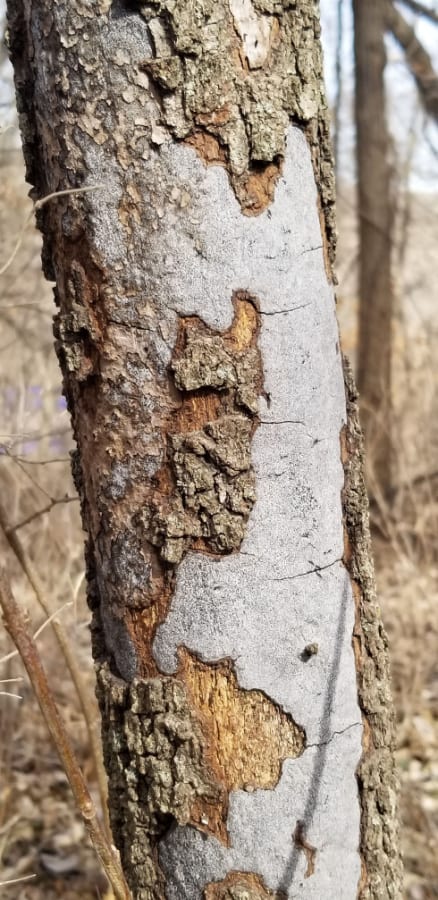
This fungal disease is the result of stress to the tree, mostly on younger oaks. These are trees that have been planted within 10 years, though it does show up on older trees. The initial symptom is a white or gray fungal mass on the trunk of the tree. Over a short time, the fungal mass falls away to reveal a black, crusty mass that looks and feels much like smooth asphalt.
Then the leaves of the trees yellow and fall away, followed by the death of the tree. Most trees die within the year that the disease appears, though I have found some woodland trees that survived winter in the first fungal stage, before dying the following summer.
How can I prevent Hypoxylon Canker?
The best way to prevent this disease is to keep the tree as healthy as possible. To do that, follow these steps:
- Keep the tree free of other diseases if possible
- Keep major insect pests at bay
- Water the tree in time of extreme drought
- Plant new trees in the best possible location
- Mulch around the base of the tree, to the dripline out if possible
- Do a soil test, and fertilize the tree accordingly
Bur Oak Blight (BOB)
To my knowledge, this is not yet a major concern in Kansas, but there have been numerous reports of it in Iowa and Nebraska. For that reason, I mention it here. Bur oak blight, also called BOB, affects only bur oaks (Q. macrocarpa). It is caused by a endophytic fungus called Tubakia iowensis.
The fungus overwinters on the petioles of dead leaves attached to the tree. In spring, when wet weather arrives, spores are produced, which spread to newly emerging leaves. Symptoms on the leaves include death of the leaf tissues along the veins and wedge-shaped areas of browning at the tips. This is often followed by defoliation of the tree.
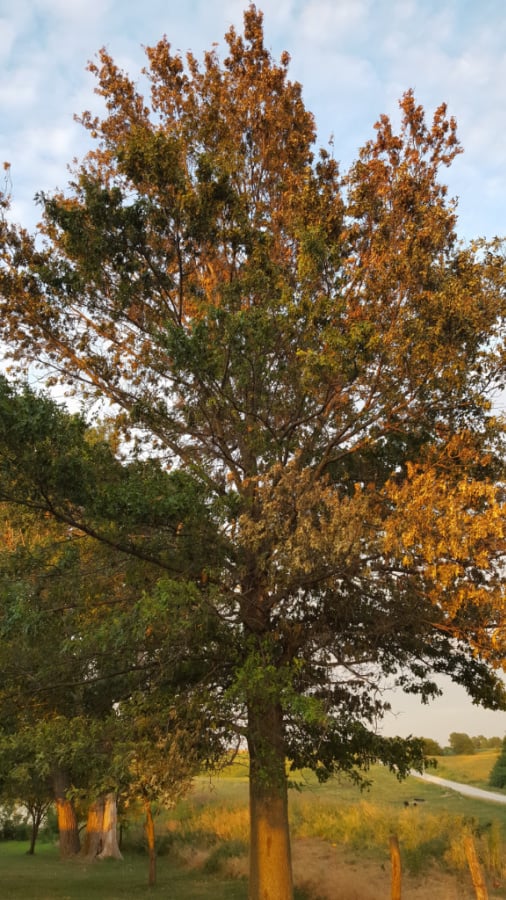
Several years of unchecked infections can lead to death of the tree. While there is no prevention of the disease, there have been some early successes with fungal applications on bur oaks in Iowa trials.
If you suspect that your bur oaks may be suffering from BOB, please send a sample to the K-State Diagnostic Lab in Manhattan, KS, or to your state’s disease diagnostic lab.
Oak Wilt
This disease, though fairly uncommon in our area, has the potential to kill many red and pin oaks. The tree, after being infected, usually dies within 1 season.
Oak wilt can be spread from tree to tree by sap-feeding insects or root grafts. To prevent initial infection, do not prune oaks of the Red Oak Group in spring or summer. If a tree is infected, do not save the wood for firewood, but remove and burn immediately.
Oak wilt causes partial leaf scorching at the top of the leaf, followed by wilting. Under the bark, plant tissues are streaked with brown. It generally starts in one branch area, and then quickly spreads to the rest of the tree. I have seen a tree become infected and die within 3 weeks.
Insect Pests of Oak Trees
Oaks host the larvae for over 500 species of moths and butterflies in North America. The vast majority of these cause little visible damage to the tree. Most are so high in the canopy you would never know they are there. But these are also not the important pests we need to know about when caring for our oak trees.
I will show you some examples of the moth caterpillars that feed on oak leaves, but do not be alarmed by them. They are part of the ecosystem and are often snatched up by birds before they can become a big problem.
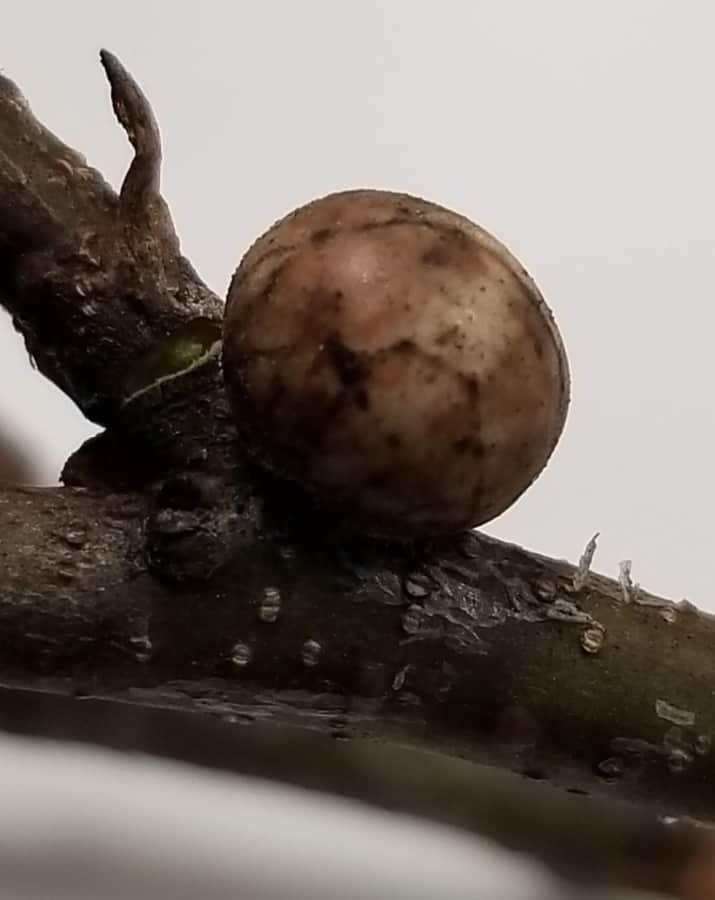
But first lets look at a couple insects that may need treatment.
Kermes Scale
I have spent an exhaustive amount of time researching and learning about this destructive pest of the Red Oak Group. There is a rumor that it also feeds on bur oaks, but I think it is more likely another member of the scales.
Kermes scale is a destructive pest that girdles the branch tips of red oak (Q. rubra), pin oak (Q. palustris), black oak (Q. velutina), and other members of the Red Oak Group. If you see flagging or dead branch tips on your oak tree, this is the likely pest. Go to my post on Kermes scale for more information.
Oak Lace Bug
Lace bugs fall into the category of plant-sucking insects. These tiny insects suck the plant juices of the leaves of the oak trees. They can be very detrimental and weaken oak trees. You will see them mostly on the White Oak Group, mainly on bur oaks (Q. macrocarpa). They can be a problem here, because if bur oaks are weakened by these insects, it may lead to BOB (see above).
The treatment for these plant-sucking insects is the same treatment as for aphids or scale. Using a systemic insecticide such as imidicloprid will eliminate the problem of lace bug feeding. However, I would only recommend this treatment if the tree is already stressed from the weather or other factors.
Moths and Caterpillars
Like I said above, most of you will never know there are caterpillars feeding on the tree. You would have to inspect multiple leaves, and be up high in the canopy to see anything. The 3 species I am going to show you I found by doing extensive searching. I turn over leaves and look for things.
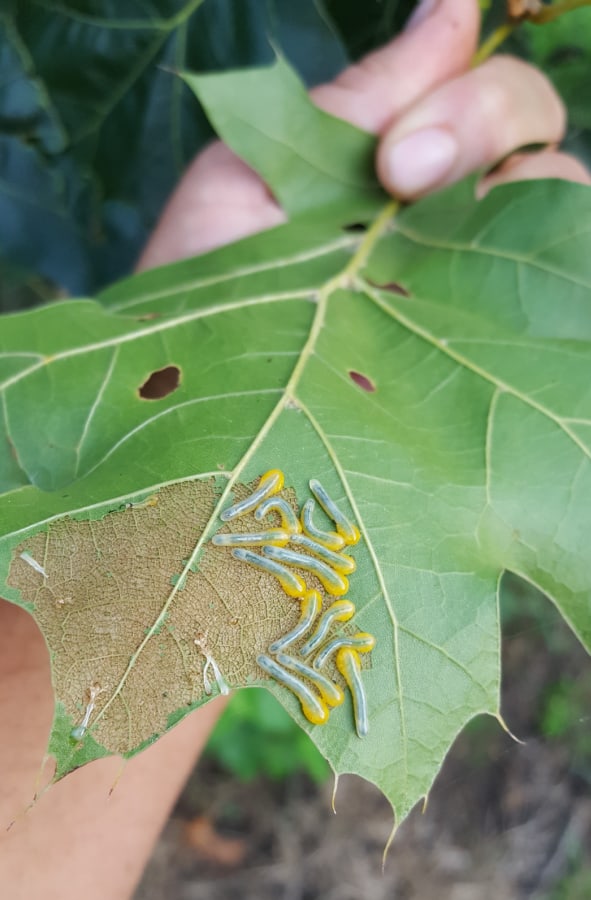

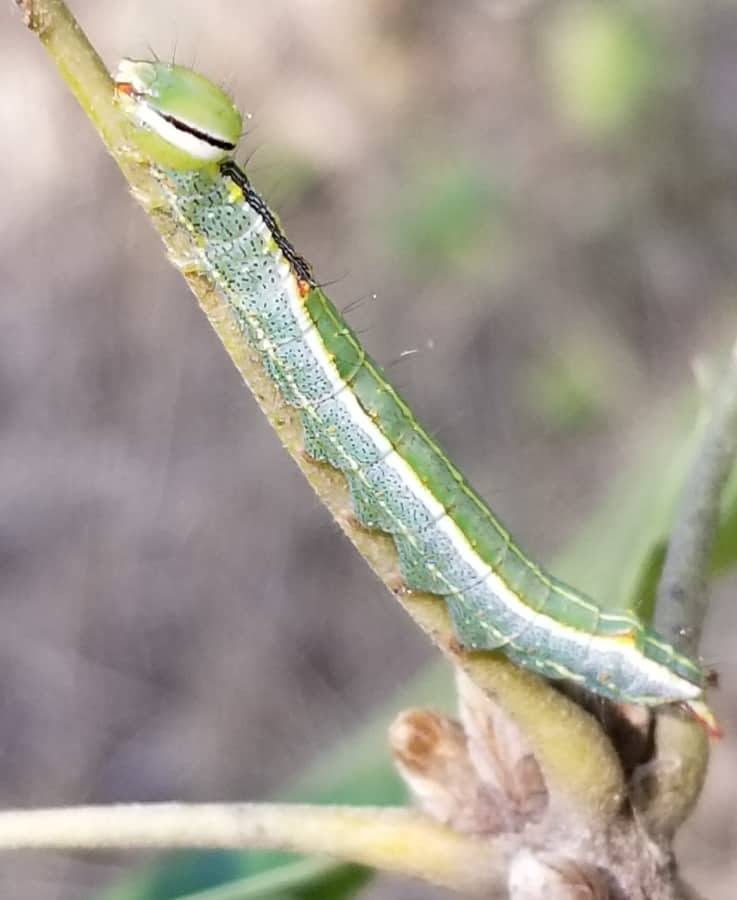
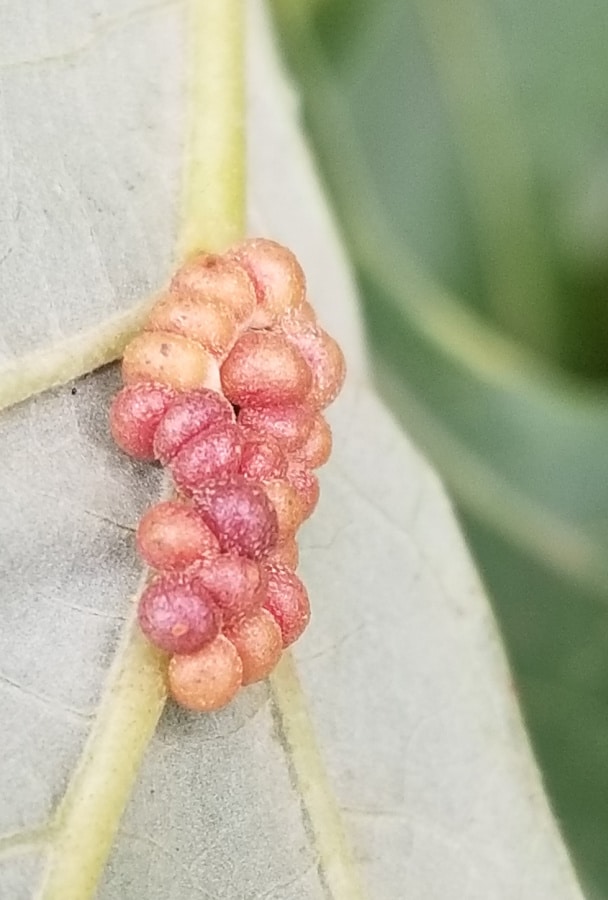
Gall Forming Insects of Oak Trees
There is a great variety of galls seen on oak trees in the central Great Plains. In fact, if you look around you, you will see many galls on many different plants. Galls are aesthetic only, they do hardly any real damage to the plant. They are formed as a reaction to an insects’ attack or egg laying process.
Of the ones I have studied, most of the gall formers on oaks are wasps. These are tiny wasps, and you would be very unlikely to catch them in the act of their attack on the tree.
One gall former that is not a wasp is the oak leaf gall midge. This tiny fly-like insect lays its eggs on the veins of the oak leaves, producing oak vein pocket galls. In these galls the midge larvae hatch and feed. And then oak itch mites feed on the midge larvae. This is where we get oak itch mites. The midge lays its eggs on members of the Red Oak Group.
Here are some examples of oak galls.
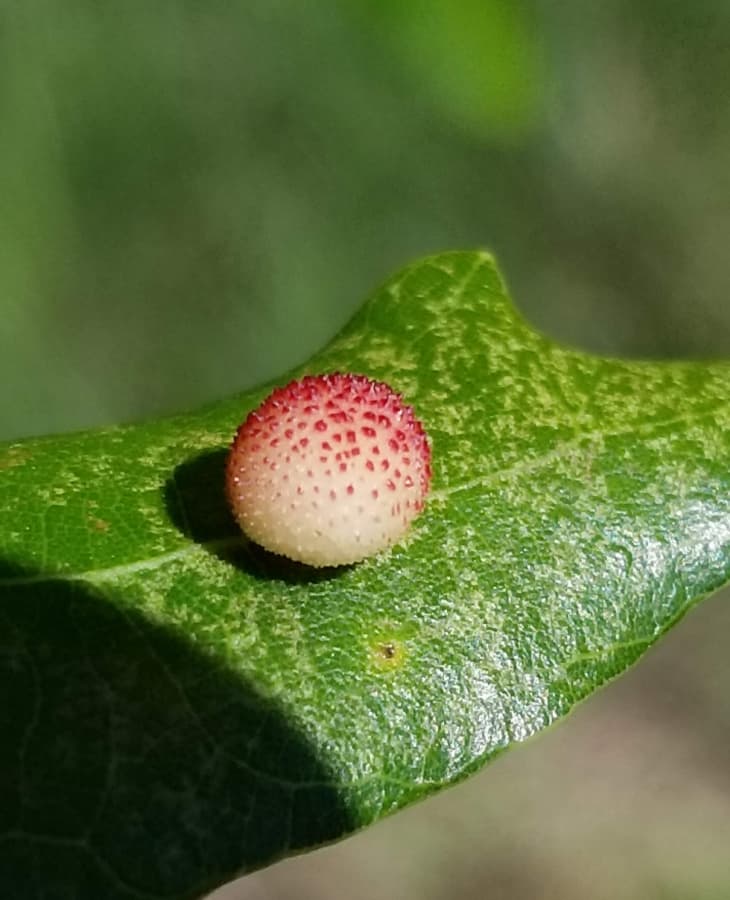

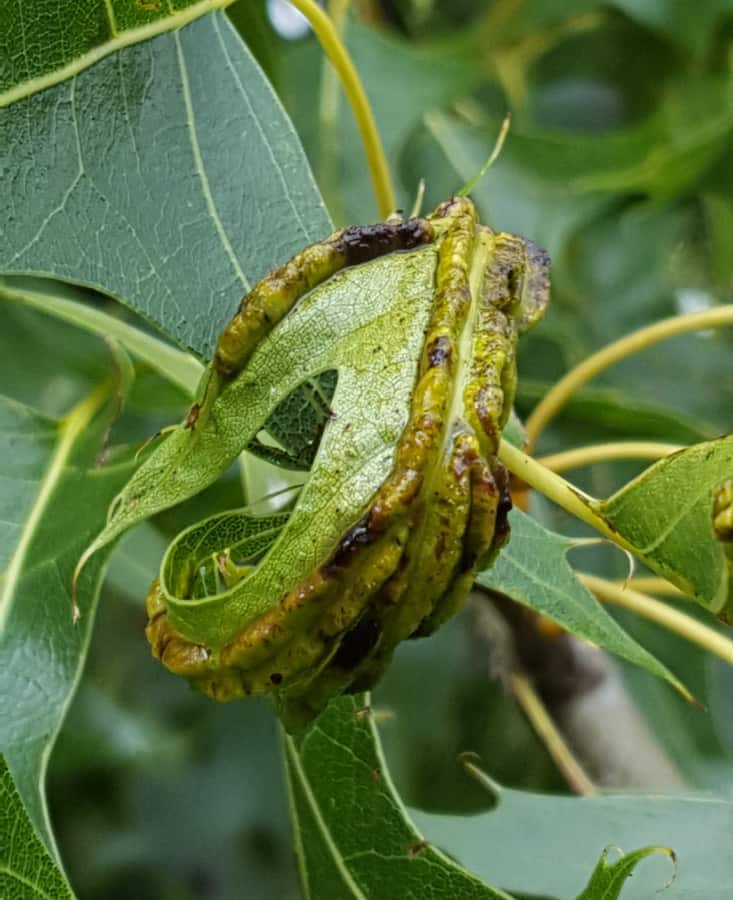
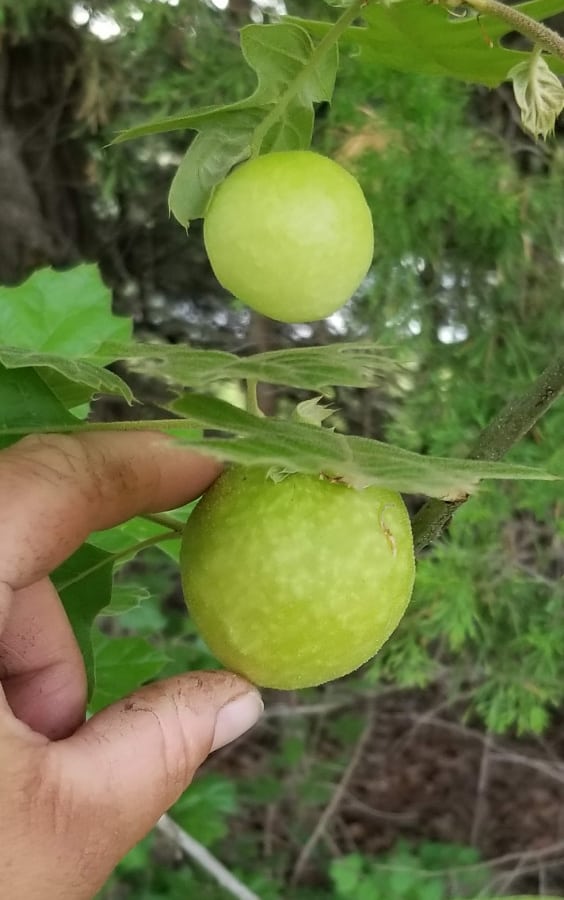
Conclusion
Oak trees are a valuable part of the ecosystem, even in a region dominated by prairies. We love our oak trees in the yard for their majesty, their shade, and their attractiveness to birds. Keeping these trees healthy should be a part of all gardener’s work.
Happy planting!





My husband and I have lived in our home in Dayton, Nevada for 11 years, and have a very large oak tree (I think it is a Shumard Oak, but it was here when we moved in, so can’t be sure). It is about 25-30 feet tall, and about 15 feet wide. It has been very healthy with never a pest on it – until this year! We had a very wet June with thunderstorms nearly every day, and tuiple-digit temps the entire month of July so far. This is the first year we’ve ever had a problem with this wonderful oak tree. We just noticed the other day that It is pretty much covered with white aphids, with all manner of bees, wasps, yellow jackets and the like tending to the aphids for their honeydew. We have roses and birch trees in our yard as well, but no aphids on either of these (which seems unusual since we’ve had problems with them in the past).
Do you find this unusual, or have we just been lucky with the oak tree in the past?
Thank you for the comment and checking out our blog.
It seems as if you have been blessed with an unusual circumstance. Blessed because you have probably had aphids, whiteflies, and/or mealybugs feeding on the oak, but not in numbers sufficient enough to see. There are some species of oaks with very few insect problems, of which are generally red, Shumard, or black oaks. They do get some problems, but they are rarely visible.
An extreme weather even such as an abnormal amount of rain, can cause more succulent growth, which in turn results in a pest outbreak. The tree normally combats pest outbreaks by releasing chemicals into the air to attract predators, as well as producing more lignin in the leaves and stems, and even sending chemicals out to the leaves (such as tannins in oaks and juglone in walnuts), to kill or drive away pests. However, because aphids reproduce quickly, they can overwhelm a plant’s defense system.
Unfortunately, with aphids, their poop is a sugar filled food source for ants, wasps, and bees. But I am sure the predator populations will rebound too, and start to take over. You should be able to find slug-like larvae feeding on the aphids, as well as smaller parasitoid wasps, lacewings, and lady beetles. If the tree is stressed, or dropping leaves because of the damage, blasting the tree with water from a hose, may be the best route to reducing the aphid populations, while also allowing predators to mostly remain in place.
Happy planting!